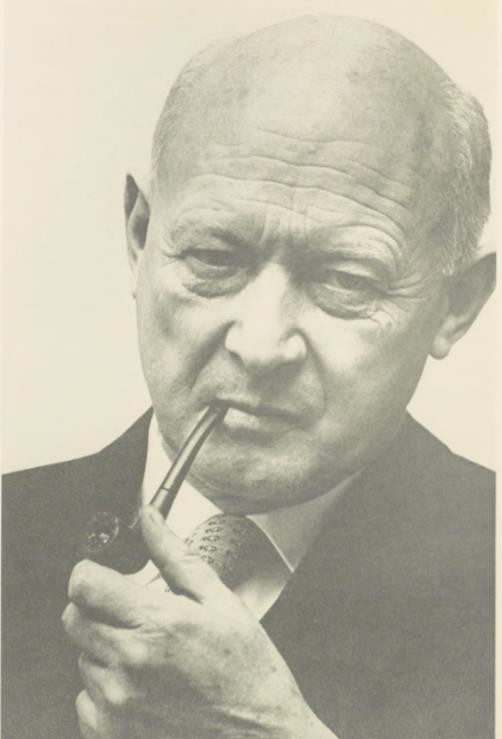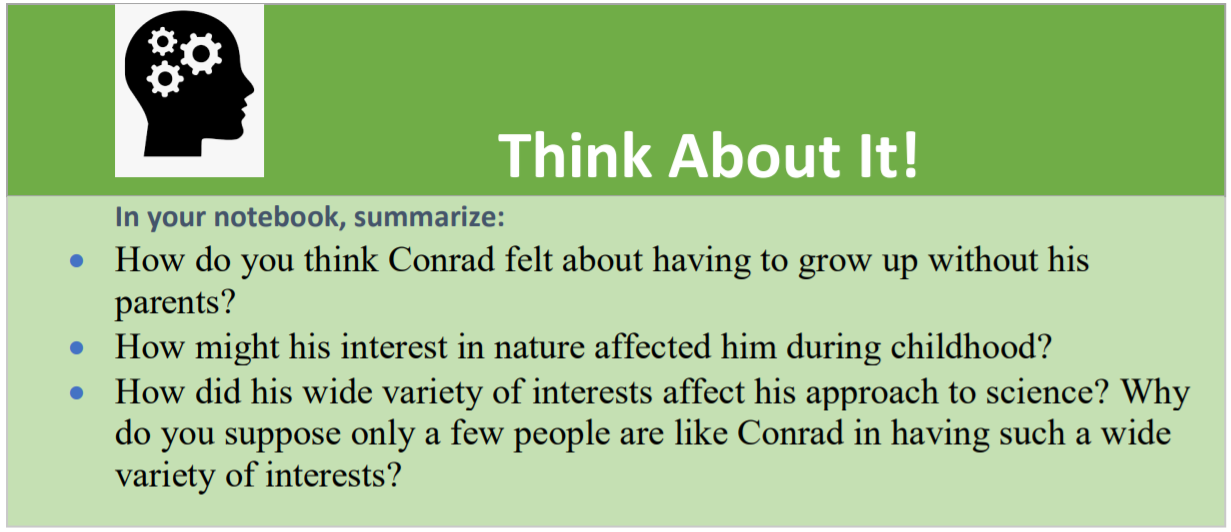Randy Jones, 7th grade student, raises his hand and asks with a disturbed expression: “Ms. Rainey, you said that maybe I should become a scientist. Why did you say that? I don’t want to be a scientist. They are such nerds.”
Ms. Rainey replies, “Well, Randy, I said that about you because you are so inquisitive, curious about so many things.
That’s the way most scientists are. They just seem “one dimensional,’ because they are so focused.”
“If you doubt me, read this sketch about Dr. Waddington. He was interested in all sorts of things that had nothing to do with science. Even in science, he was interested in chemistry, evolution, fossils, geology, genetics, and experimental embryology. He finally more or less stumbled into a career path involving epigenetics, where his ideas made him famous and are influencing today’s genetic research some 50 years after his death.”
 Back in the late 1920s, scientists were discovering that the development of embryos depended on the timing and activation of genes. They even discovered that certain chemical and physical changes as the embryo developed determined if and when genes were “turned on” to “do their thing.” Today, we call that “gene expression.” But scientists of that day didn’t know enough about genes to get much beyond that understanding.
Back in the late 1920s, scientists were discovering that the development of embryos depended on the timing and activation of genes. They even discovered that certain chemical and physical changes as the embryo developed determined if and when genes were “turned on” to “do their thing.” Today, we call that “gene expression.” But scientists of that day didn’t know enough about genes to get much beyond that understanding.
By the late 1940s scientists discovered that genes are made up of nucleotides, ribose, and phosphate groups (PO4). Then it took many decades before Watson and Crick determined how these DNA molecules were bound together in three dimensions. Scientific interest shifted to studies of gene sequences and determination of how they direct RNA to make proteins. You might say that scientists became distracted from the earlier work on gene expression.
However, Waddington and others in his era had demonstrated that methyl groups were sometimes tacked on to DNA nucleotides. Such changes could alter the way the genes were expressed. They also discovered that gene expression was regulated by the proteins surrounding DNA, histone proteins that make up the chromatin that bundles DNA into chromosomes. Today, there is renewed interest in learning what determines when or if these epigenetic effects occur. Medical applications involve how to regulate epigenetic effects. The potential for preventive medicine and treatment of disease is enormous. Especially emphasized is how environmental influences cause toxic and cancer-inducing epigenetic change. Can we prevent such bad effects or reverse the epigenetic changes that cause them?
Meet the Scientist,
Conrad Waddington
1905-1975

Conrad came from a family of Quakers in England. However, his first four years of his life were in southern Madras part of India, where his father was a tea grower. The English are big tea drinkers, and this part of India is a great place to grow tea. At that time, India was a British colony, and England used India as a major source for importing tea. For Conrad’s father, it must have been a good business.
For some undisclosed reason, Conrad and his sister were sent back to England without their parents. Conrad was raised by an aunt and uncle who had a son his age. They lived on a small farm.
On school holidays and many other days, Conrad spent time with his grandmother, who was raising his sister. Grandmother was a Quaker who had strict rules for what one was allowed to do on Sundays. On Sundays when Conrad was at her house, he was not allowed to do anything frivolous. After lunch, everybody went into the living room to visit and pursue hobbies.
Often, grandmother read to Conrad and his sister, but only from books on serious subjects. Conrad also read for himself, often books dealing with nature.
Conrad spent a lot of time with a local Quaker, Dr. Doeg, who ran a chemist’s shop (drug store) in town. Dr. Doeg was a distant relative, whom Conrad regarded as a grandpa.
Dr. Doeg was interested in all kinds of science. He shared those interests with Conrad. On those Sunday afternoons at grandma’s house, and weekdays too, Dr. Doeg would show Conrad fossils and tell him their names. He showed Conrad bits of animals or plants under the microscope. He taught Conrad about lenses, prisms, and magnets. He gave Conrad chemicals to experiment with.
Conrad especially like to collect things, like snails and fossils. Grandmother was a bit of a naturalist too. Conrad was given access to a room next to the barn, where he did chemical experiments and stored his collections. This room was like a natural history museum.
In school, Conrad went on archeological digs and fossil collection trips. The headmaster (principal) noticed Conrad’s interest in scientific things and encouraged him.
As you can see, Conrad did not have a conventional family life. World War I disrupted the ability of his parents to travel and be with him. Between the ages of 5-15, Conrad never saw his father. By the time both parents moved back to England, Conrad was already grown and married.

When Conrad reached college age, people thought he was much older than he really was, because he had become prematurely bald at age 21. Conrad was awarded a scholarship to go to college at the University of Cambridge, where he graduated with a major in natural science. He married in the year of graduation, and he and his wife stayed on in the university town. They spent many evenings with friends talking about science, philosophy, modern art (his wife’s interest), music and dancing. Conrad liked to dance and even gave lessons and dance tours. He also developed an interest in poetry and while still in college became an editor and publisher of a poetry magazine.
Conrad decided to do graduate work in geology, because he thought being an oil geologist would provide a good living. His world was becoming industrialized and heavily dependent on oil for energy. He apparently had two scholarship, one in paleontology and one in philosophy. He survived on various fellowships and acting as a teaching assistant.
In 1938, at age 33, Conrad finally got a doctorate degree. One of his tutors got him interested in evolution, and another, the son of the famous geneticist, William Bateson, stirred an interest in genetics. Conrad became even more interested in embryology after reading publications of Hans Spemann, who received the Nobel Prize for discovering a cluster of cells in amphibians that induces the development of the nervous system. This caused him to switch his studies to embryology and serve as a teaching assistant in the department of zoology.
By the 1942, Britain was under great threat of being invaded by Germany, and Conrad joined the British military. He was responsible for the section dealing with photographic reconnaissance and with anti-shipping strikes. As the war ended, Conrad had to look for a civilian job. Staying on at Cambridge did not seem promising.
He was stirred to an interest in agricultural genetics when two American agriculturists came to Britain to advise on agriculture policy. They offered him a job as chief geneticist. Conrad accepted, but soon afterward in 1945 he was offered the job of head of the genetics program at the University of Edinburgh, in Scotland. Among his first tasks was to recruit and hire staff and faculty for the genetics program. He then created a degree program in animal genetics. Soon, the department was the largest of its kind not only in Britain but also in the world.
By the 1950s, genetics research around the world was revealing that chemical modifications of DNA that might influence how genes are turned on or off. Waddington convinced his university authorities to create a research laboratory in epigenetics. He had actually invented the word, “epigenetics.” However, epigenetics did not thrive in this era, because scientists were drawn to the new field of molecular biology and an interest in DNA, RNA, and the mechanisms protein synthesis.
One consequence of the molecular biology revolution is that Conrad decided that his kind of genetics was not sufficiently popular in Britain to make a living. So, Waddington was drawn back to his earlier interest in experimental embryology, which opened doors for him to become increasingly recognized as a leader in embryology, receiving many awards, honorary doctorates, and leadership positions with international research organizations, government, and journal publishers. Sadly, he succumbed to a series of heart attacks in the early 1970s.
His contributions to epigenetics were inspired, as mentioned, by Spemann’s research indicating that embryonic development involved activation of certain genes by physical and chemical changes in embryonic tissue. Conrad’s research involved developing methods for studying tissue induction in chicks and mammals. He persuaded biologists to accept that cell differentiation and organ development of the embryo were epigenetic processes.
Conrad pioneered the idea that chromosomal protein structure was a crucial context for gene expression. He contributed important research showing that induction can be triggered by certain chemicals in the environment. Waddington’s books on embryonic development introduced many of the now-accepted terms and ideas about epigenetics. But he wrote popular articles and books in other fields as well, such as the interplay of modern art and science and science philosophy and ethics.
He called for refinement of the theory of evolution to include the impact of epigenetics. He argued that epigenetic changes could influence evolutionary adaptiveness. He also resurrected the discredited idea that characteristics acquired during one’s life might be passed on genetically to heirs by way of epigenetic changes. Today, everyone accepts the reality of epigenetic change in cells of various bodily tissues, but little research has been performed on epigenetic change in sperm and ova.
Conrad’s wide-ranging interest in science no doubt helped him arrive at “big picture” theoretical views of biology that require new approaches that treat life as built upon complex systems of biochemistry and physical forces acting at the genetic and epigenetic levels. He stoutly defended theoretical biology and argued for a research emphasis on the basic control mechanisms that regulate gene expression and complex phenomena associated with the development, regulation, and evolution of organisms.
Conrad’s call for systems-level research was in the 1950-1970s, an era of scientific “reductionism” in which scientists were learning more and more about less and less. That approach to biology still dominates. However, Waddington’s recommendations for complex systems research are now being pursued by many researchers. Geneticists now know that things are not as simple as thinking in terms of one-gene, one protein. It was Waddington who was most responsible for putting genes into a larger context of the biochemical and physical environment in which they operate.
Sources:
- Hall, Brian K. (2008). Conrad H. Waddington: Towards a theoretical biology. Biological Theory. 3(3):233-237. DOI: 10.1162/biot.2008.3.3.233
- Robertson, Alan (n.d.) Conrad Hal Waddington. https://royalsocietypublishing.org/doi/pdf/10.1098/rsbm.1977.0022
- Van Speybroeck, Linda (2002). From epigenesis to epigenetics. Ann. N.Y. Acad. Sci. 981: 61–81.
Author: W. R. Klemm
Test Yourself

Time's up
ALL sections
- Main Menu
- Overview
- Essential Knowledge: Variation in Traits
- Essential Knowledge: Genetics & One Health
- Essential Knowledge: Asexual & Sexual Reproduction
- Essential Knowledge: DNA & Alleles
- Essential Knowledge: Predicting Traits
- Backpack Adventures
- Make a Note of That
- Meet a Scientist
- Practice
- Real Science Review
- Scientist videos
